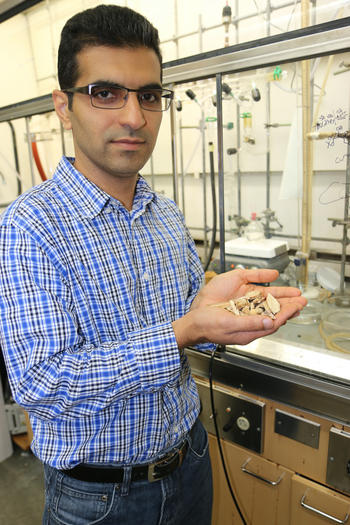New process transforms wood, crop waste into valuable chemicals
Scientists today disclosed a new method to convert lignin, a biomass waste product, into simple chemicals. The innovation is an important step toward replacing petroleum-based fuels and chemicals with biorenewable materials, says Shannon Stahl, an expert in “green chemistry” at the University of Wisconsin–Madison.
Lignin is the substance that makes trees and cornstalks sturdy, and it accounts for nearly 30 percent of the organic carbon in the biosphere. Stahl, senior author of a new report in the journal Nature, notes that lignin is a waste product of the paper industry, where cellulose is the valuable product. “Lignin is burned as a low-value fuel, but if biofuels are to become a reality, we need to get more value from lignin,” he explains.

Shannon Stahl
Lignin is a complex material containing chains of six-carbon rings. These rings, called “aromatics,” could be the basis for a sustainable supply of useful chemicals — but only if the chains of lignin can be broken down into the individual units.
“Lignin is the only large volume renewable feedstock that contains aromatics,” says Stahl. “Aromatics are used to make many things, from plastic soda bottles to Kevlar to pesticides and pharmaceuticals. Today, the aromatics are almost exclusively derived from petroleum. We need to find an economical way to convert lignin to value-added materials.”
Unfortunately, lignin is highly resistant to breakdown into the valuable subunits, especially in a cost-effective way. “People are constantly reminding me of the old adage, ‘You can make anything from lignin, except money,'” he quips.
Today’s report may change that perception. In work funded by the Great Lakes Bioenergy Research Center at UW–Madison, Stahl and his colleagues show that high yields of the aromatics may be obtained by exposure of lignin to oxygen followed by treatment with a weak acid under mild conditions.

Alireza Rahimi
Photo: David Tenenbaum
“The oxidation step weakens the links in the lignin chains,” notes Alireza Rahimi, a UW postdoctoral researcher and first author of the Nature paper. The initial oxygen treatment step was reported by Rahimi and Stahl last year. “The acid then breaks the links.”
Rahimi says he explored many different approaches to break down the lignin. “For example, hydrogen peroxide works, but it decomposes some of the aromatic products.”
They were trying various metals under acidic conditions, when they discovered that acid without metals gave the best result. “Under these conditions, the aromatics formed in significantly higher yields than anyone has observed previously,” notes Rahimi.
Any process that competes in industry must be economical, and Stahl says avoiding metals in the process is one of several advantages. “The mild conditions, with relatively low temperatures (110 degrees Celsius/230 degrees Fahrenheit) and low pressures, as well as the lack of need for expensive metal catalysts, makes it different from many other approaches.”

Josh Coon
Stahl concedes that the chemicals they obtain from their process still require further manipulation before they have real market value. “But we have a head start on this, because we know the main products that we’re making,” Stahl says.
He is referring to the work of collaborator Josh Coon, a professor of chemistry and co-author of the Nature report. “Lignin is a complex polymer, and we didn’t know how easy it would be to identify the products of this process,” says Coon.
Coon is an expert in analytical chemistry and mass spectrometry, a technique that can pinpoint the identity of specific compounds. He and graduate student Arne Ulbrich showed that the product mixture closely matches the distribution of subunits in the natural lignin.
Stahl sees lignin as a key to future “biorefineries” that would use renewable biomass rather than petroleum as the feedstock to produce fuels or chemicals while reducing environmental impact. “Most of the focus in this field has been on cellulose, but I don’t think there will be sufficient value to compete with petroleum unless we can generate value from lignin, too.”
The process described in today’s report, which is the basis of a patent application filed through the Wisconsin Alumni Research Foundation, represents an important step toward that goal.




